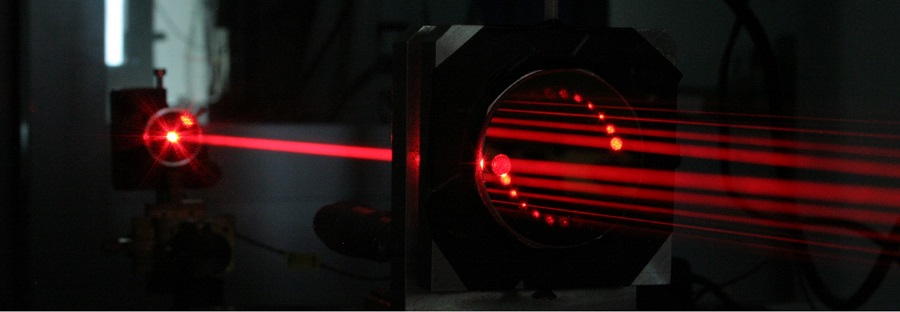About
16 November 2020
New Optical Method Paves Way to Breath Test for Cancer Biomarker
Sensitive spectroscopy approach detects formaldehyde at a level of just 1 part per million
WASHINGTON — Researchers have developed an extremely sensitive, yet simple optical method for detecting formaldehyde in a person’s breath. Because formaldehyde is being studied as a potential biomarker for lung and breast cancer, the new method could one day lead to an inexpensive and fast way to screen for cancer.
“Measuring biomarkers in exhaled breath is noninvasive, painless and fast and could be used to screen for cancer even at very early disease stages, which is crucial for successful treatment,” said research team leader Mateusz Winkowski from the University of Warsaw in Poland. “The optical method we developed could make this type of measurement more practical and inexpensive.”

Caption: Researchers have developed an extremely sensitive, yet simple optical method for detecting formaldehyde. Their approach is based on multipass spectroscopy, which introduces a laser through a small hole in a mirror. The laser light then bounces back and forth between mirrors, creating interaction lengths with the sample that are tens or hundreds of times the length of the cell.
Credit: Mateusz Winkowski, University of Warsaw
In The Optical Society (OSA) journal Biomedical Optics Express, Winkowski and Tadeusz Stacewicz show that their new optical sensing method based on multipass spectroscopy can detect the presence of 1 molecule of formaldehyde in a million air particles, or 1 part per million, even in the presence of gasses that can interfere with optical measurements.
“Our dream is to one day build a table-top device that would be inexpensive and could be used for cancer screening in any medical consulting room,” said Winkowski. “During a basic medical examination, the patient could blow into the device, and within a minute the doctor would know if the patient might need additional conventional examinations.”
Boosting sensitivity
Spectroscopy can be used to identify the chemical composition of a substance by measuring the color of light absorbed or emitted from a sample. A spectroscopy approach known as multipass is useful for detecting low concentrations of gas molecules because it increases the extent to which the light interacts with the sample. This setup uses an experimental cell with a mirror on each end. A laser introduced through a small hole in one mirror then bounces back and forth in the cell, creating interaction lengths tens or hundreds of times the length of the cell.
When trying to detect extremely low concentrations, noise can be a problem with multipass spectroscopy. This is because the multiple laser beams create a type of optical interference called fringe interference that decreases sensitivity and makes it impossible to precisely determine the biomarker concentration. To reduce this optical interference, the researchers developed a method called optical fringe quenching.
For the new optical fringe quenching technique, the researchers slightly change, or modulate, the emission of the laser over a range of wavelengths and then average the light emitted from the sample over these wavelengths. This helps eliminate the optical interference enough to allow detection of formaldehyde. The researchers also selected a spectral range and sample pressure that helped reduce interference from other constituents found in breath samples.
Optical sensing of formaldehyde
The researchers tested their new approach using calibrated artificial mixtures of formaldehyde in air. Their results showed that the approach was more than sufficient to detect formaldehyde in breath at levels that might indicate the presence of disease.
“Our optical fringe quenching technique can be used to improve any optical system that uses a multipass cell,” said Winkowski. “It could also be useful for measuring formaldehyde gas emitted from household materials or industrial sources to better understand its effects on human health.”
Next, the researchers plan to test their analysis approach’s ability to measure ethane gas in breath. Study findings have suggested that ethane might also be used as a biomarker for cancer and other diseases.
Paper: M. Winkowski, T. Stacewicz, “Optical detection of formaldehyde in air in the 3.6 μm range,” Biomed. Opt. Express, volume 11, issue 12, pp. 7019-7031 (2020).
DOI: https://doi.org/10.1364/BOE.405384.
About The Optical Society
The Optical Society (OSA) is dedicated to promoting the generation, application, archiving, and dissemination of knowledge in optics and photonics worldwide. Founded in 1916, it is the leading organization for scientists, engineers, business professionals, students, and others interested in the science of light. OSA’s renowned publications, meetings, online resources, and in-person activities fuel discoveries, shape real-life applications and accelerate scientific, technical, and educational achievement.
About Biomedical Optics Express
Biomedical Optics Express serves the biomedical optics community with rapid, open-access, peer-reviewed papers related to optics, photonics and imaging in biomedicine. The journal scope encompasses fundamental research, technology development, biomedical studies and clinical applications. It is published monthly by Optica Publishing Group and edited by Christoph Hitzenberger, Medical University of Vienna, Austria. For more information, visit Biomedical Optics Express.
Media Contact
